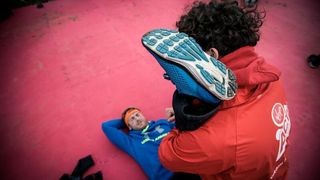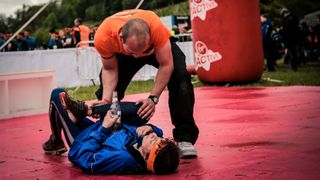How to prevent an obstacle course injury
Use these nutrition tips, gadgets and exercise drills to ensure injury doesn’t sabotage your race

Clever nutrition, simple training gear and quick exercise drills will all help reduce the risk of injury as you train for and ultimately tackle your OCR. Here are the nine key steps you should take to give yourself the best chance of crossing the finish line in one, pain-free piece.
1. Train with your mouth full
What you eat during a training session is as vital as what you put in your body to fuel it before and replenish it after. ‘I'm a big fan of intra-workout nutrition,’ says nutritionist and strength coach Mishal Dasani (ownyourfitness.co.uk). ‘Getting adequate nutrients into the muscle during the training session will ensure faster recovery meaning you are able to train more often. A protein-to-carbs ratio of 1:3 will sustain your workout and help you recover as quickly as possible. Use an intra-workout shake for training and protein and carb bars for the race itself. The amount used is highly dependent on the intensity and duration of the workout. As few as 30g of carbs is adequate for a 60-minute workout. Scale up accordingly.’
2. Sleep on it
The secret your physio never wanted you to know is out: sleep is the sworn enemy of injuries. New US research has shown that if you get less than eight hours per night you increase your risk of injury by 1.7 times as those getting more shut-eye. The best way to make sure you’re hitting your quota is by tracking it. The SmartWatch 3 from Sony can track your sleep and by downloading Sony’s Lifelog app you can view your sleep behaviour on your Xperia™ Z3+. You can set an alarm to vibrate and get you up in the morning, so you don’t miss your workout.
SmartWatch 3, from £189.99
http://www.sonymobile.com/gb/products/smartwear/smartwatch-3-swr50/
Get the Coach Newsletter
Sign up for workout ideas, training advice, reviews of the latest gear and more.
3. Avoid splinter hell
As debilitating as a common stitch, shin splints can strike at any time – unless you take precautions. ‘Medial tibial stress syndrome, also known as shin splints, primarily relates to pain originating from the inner aspect of the shinbone caused by an abrupt increase in training volume that doesn’t give the bone time to adapt,’ says physio David Wynne (westlondonphysio.co.uk). ‘If you start to increase your running frequency, do so gradually. Runners increasing their weekly distance by more than 30% have a higher risk of injury than those increasing it by 10%. Once you discover your base level of endurance – for instance, on your first run – only increase your overall weekly time or distance by 10% per week, and don’t increase both speed and distance at once.’ Use the SmartWatch 3 and Xperia Z3+ from Sony to monitor your training volume and make sure you don’t pick up your weekly pace too fast.

4. Eat big
Your training session isn’t finished when you’ve lifted the last rep or kicked off your running shoes. Getting your post workout nutrition right will ensure your hard work isn’t undone by a slow recovery. ‘An ideal post-race meal must include protein and carbs,’ says Dasani. ‘If you're absolutely starving, grab a shake or a banana to tide you over, but your main focus should be getting a good meal down you. I'm a big fan of a post-workout meal based around turkey and either white rice or sweet potato. These foods are easy to digest and have minimal stress impact on the gut, which means you absorb the nutrients faster and recover quicker. There's no rush to get this meal in either as glycogen replenishment can occur hours after exercise. Eat big and enjoy it.’
5. Dress to compress
Slipping into something snug but not necessarily more comfortable during and especially after your training session is an easy way of reducing your injury risk and dramatically less painful than ironing out knots with a foam roller (although this is encouraged too). ‘Wearing compression shorts, socks or leggings during and after lower-body workouts or runs can help prevent hamstring strains and encourage faster recovery from delayed onset muscle soreness,’ says Wynne.
2XU Men’s Elite Compression Tights, £110 2xu.co.uk
http://www.2xu.co.uk/elite-compression-tights-ma1936b.html
6. No sprain, all gain
Leaping onto precarious obstacles and racing around uneven off-road terrain can play havoc with your ankles. ‘Lateral sprains are the most common ankle injury you’ll face,’ says physio Simon Rice (puresportsmed.com). However, you can take precautions to reduce the risk. ‘Calf strength and proprioceptive balance exercises can be effective in reducing risks. Before training warm up the ankle muscles around your ankle using a Bosu ball. Stand on the soft side of it on one leg with your eyes closed and then hop on and off it. Do ten hops on each foot three times. Focus on making a soft, quiet landing.’
7. Put your back into it
The glutes are the number one muscle group you should focus on to protect your body as you hurl it over, under and through the hazardous obstacles you’ll encounter. And the beauty is, by doing mini band clam exercises (where you open your legs, mimicking the opening of a shell), you can do it lying down. ‘Weak or underactive glutes can cause misalignment between the hips, knees and ankles leading to the possibility of injury, especially to the knee and ankle ligaments,’ says Andy Wiseman, former professional football player and current S&C coach (Six3Nine.com). ‘By keeping the glutes activated and ready for action, you can reduce your chances of injury and perform better.’ Lying on your side, wrap the bands around your legs just above your knees. Rest your head on your arm and bend at your hips 45°. Bend your knees 90° and keep your feet in contact throughout. Keeping your bottom leg down, slowly open your knees until your knee is almost pointing straight up, then lower it to the start. Do three sets of ten on each side, focusing on a slow and controlled tempo.
8. Skip runner’s knee
Avoid the dreaded scourge of iliotibial band friction syndrome, also known as runner’s knee with some effective lower body moves. ‘The IT band is a thick layer of tissue that runs along the outer aspect of your thigh,’ says Wynne. ‘If your glutes and quads are weak your IT band can rub against a small sac of fluid on the outside of your knee, causing pain and inflammation.’ Strengthen these muscles with single-leg glute bridges, step-ups and lunges. Do three sets of 15 reps, building up to four sets of eight reps with heavier weights.’
9 Got the minerals?
Vitamin and mineral supplements aren’t just useful for keeping you healthy, they’re equally important for keeping you injury-free too. ‘For some serious help with recovery get your hands on a good magnesium supplement to have with this meal,’ says Dasani. ‘Alternatively, have a hot bath after training with some magnesium salt flakes in the tub. This will decrease soreness, replenish lost minerals, calm the nervous system and aid recovery.’
Find out more about the Xperia Z3+ from Sony and its benefits for your Tough Mudder preparations
Coach is a health and fitness title. This byline is used for posting sponsored content, book extracts and the like. It is also used as a placeholder for articles published a long time ago when the original author is unclear. You can find out more about this publication and find the contact details of the editorial team on the About Us page.

Coros Vertix 2S Review: The Garmin Fenix Rival Gets Some Useful Upgrades

I Tried CrossFit Champ Mat Fraser’s Signature 40-Minute EMOM And It Helped Me Build Strength, Skill And Endurance In One Fell Swoop

I Took A Test To Find Out If I Had What It Takes To Be An Elite Athlete And It’s Changed My Training For The Better
